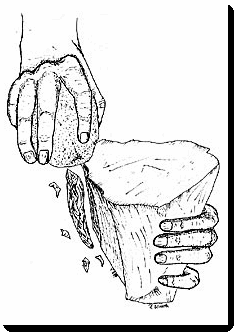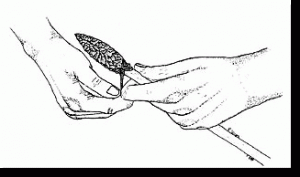Stone tools such as spear points were made through a process called flintknapping. Striking a rock in a particular way causes flakes/chips to come off. Learning to strike the rocks in the best way takes lots of practice and involves many mistakes. Even today, with patience and learned skill, people can make spear points out of stone.

The first step in making a tool from a piece of raw material is to remove the weathered surface called cortex. The piece of raw material is struck with a hammerstone which causes large flakes to be driven off. Some of these flakes may be used later to make smaller tools such as scrapers or triangular points.

Shaping the piece into the desired tool form is the second step in the tool making process. Early stages of this process are done using a hammerstone. For the later and finer work a baton of wood or antler is used to thin the edges and to establish the form.
Pressure flaking is the last step in making the stone tool. Very small, thin flakes are carefully removed from around the margins of the tool by applying pressure with an antler tine. This type of flaking strengthens, straightens and sharpens the cutting edges of the tool and shapes the piece into its final form.

